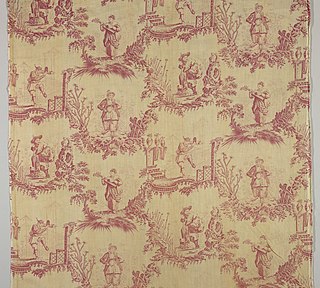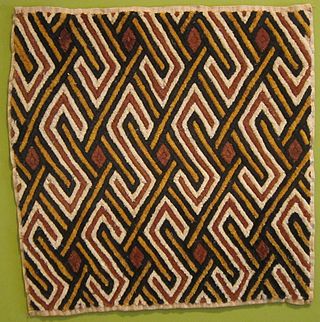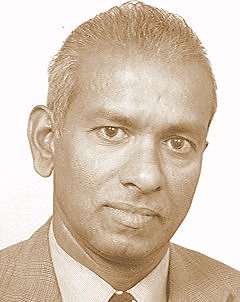Related Research Articles

Textile is an umbrella term that includes various fiber-based materials, including fibers, yarns, filaments, threads, different fabric types, etc. At first, the word "textiles" only referred to woven fabrics. However, weaving is not the only manufacturing method, and many other methods were later developed to form textile structures based on their intended use. Knitting and non-woven are other popular types of fabric manufacturing. In the contemporary world, textiles satisfy the material needs for versatile applications, from simple daily clothing to bulletproof jackets, spacesuits, and doctor's gowns.

Weaving is a method of textile production in which two distinct sets of yarns or threads are interlaced at right angles to form a fabric or cloth. Other methods are knitting, crocheting, felting, and braiding or plaiting. The longitudinal threads are called the warp and the lateral threads are the weft, woof, or filling. The method in which these threads are interwoven affects the characteristics of the cloth. Cloth is usually woven on a loom, a device that holds the warp threads in place while filling threads are woven through them. A fabric band that meets this definition of cloth can also be made using other methods, including tablet weaving, back strap loom, or other techniques that can be done without looms.

Muslin is a cotton fabric of plain weave. It is made in a wide range of weights from delicate sheers to coarse sheeting. It is commonly believed that it gets its name from the city of Mosul, Iraq.

Percale is a closely woven plain-weave fabric often used for bed covers. Percale has a thread count of about 180 or higher and is noticeably tighter than twill or sateen. It has medium weight, is firm and smooth with no gloss, and washes very well. It is made from both carded and combed yarns, and may be woven of various fibers, such as cotton, polyester, or various blends.

A palampore or (Palempore) is a type of hand-painted and mordant-dyed bed cover or hanging panel that was made in India for the export market during the eighteenth century and nineteenth century.
Longcloth refers to a plain cotton cloth originally made in comparatively long pieces.

Broadcloth is a dense, plain woven cloth, historically made of wool. The defining characteristic of broadcloth is not its finished width but the fact that it was woven much wider and then heavily milled in order to shrink it to the required width. The effect of the milling process is to draw the yarns much closer together than could be achieved in the loom and allow the individual fibres of the wool to bind together in a felting process, which results in a dense, blind face cloth with a stiff drape which is highly weather-resistant, hard wearing and capable of taking a cut edge without the need for being hemmed.

African textiles are textiles from various locations across the African continent. Across Africa, there are many distinctive styles, techniques, dyeing methods, and decorative and functional purposes. These textiles hold cultural significance and also have significance as historical documents of African design.

The economy of the ancient Tamil country describes the ancient economy of a region in southern India that mostly covers the present-day states of Tamil Nadu and Kerala. The main economic activities were agriculture, weaving, pearl fishery, manufacturing and construction. Paddy was the most important crop; it was the staple cereal and served as a medium of exchange for inland trade. Pepper, millets, grams and sugarcane were other commonly grown crops. Madurai and Urayur were important centers for the textile industry; Korkai was the center of the pearl trade. Industrial activity flourished.
Weaving and cloth trading communities of Western India particularly of Gujarat are called Vankar/Wankar/Vaniya. The four major woven fabrics produced by these communities are cotton, silk, khadi and linen. Today majority of these community members are not engaged in their ancestral weaving occupation still some population of these community contribute themselves in traditional handloom weaving of famous Patola of Patan, Kachchh shawl of Bhujodi in Kutch, Gharchola and Crotchet of Jamnagar, Zari of Surat, Mashroo of Patan and Mandvi in Kutch, Bandhani of Jamnagar, Anjar and Bhuj, Motif, Leheria, Dhamakda and Ajrak, Nagri sari, Tangaliya Shawl, Dhurrie, Kediyu, Heer Bharat, Abhala, Phento and art of Gudri. Vankar is described as a caste as well as a community.

Sinnappah Arasaratnam was a Sri Lankan academic, historian and author, born during British colonial rule. Known as 'Arasa', he was a lecturer at the University of Ceylon, University of Malaya and University of New England (Australia).

The Shrewsbury Drapers Company was a trade organisation founded in 1462 in the town of Shrewsbury, Shropshire, England. The members were wholesale dealers in wool and later woollen cloth. The Company dominated the trade in Welsh cloth and in 1566 was given a regional monopoly in the Welsh Wool trade. In the seventeenth century the trade had difficulties particularly during the English Civil war and then further declined in the eighteenth century with the industrialisation of cloth production and the improvement of transport infrastructure. This made it practical for merchants from Liverpool and elsewhere to travel into Wales and purchase cloth directly from the producers. The Reform Acts of the early nineteenth century took away the power of the trade guilds and the trade ceased. Since that time the Shrewsbury Drapers Company has survived and continues as a charity that runs almshouses in Shrewsbury.

Muslin, a Phuti carpus cotton fabric of plain weave, was historically hand woven in the areas of Dhaka and Sonargaon in Bangladesh and exported for many centuries. The region forms the eastern part of the historic region of Bengal. The muslin trade at one time made the Ganges delta and what is now Bangladesh into one of the most prosperous parts of the world. Of all the unique elements that must come together to manufacture muslin, none is as unique as the cotton, the famous "phuti karpas", scientifically known as Gossypium arboreum var. neglecta. Dhaka muslin was immensely popular and sold across the globe for millennia. Muslin from "India" is mentioned in the book Periplus of the Erythraean Sea, authored by an anonymous Egyptian merchant around 2,000 years ago, it was appreciated by the Ancient Greeks and Romans, and the fabled fabric was the pinnacle of European fashion in the 18th and 19th century. Production ceased sometime in the late 19th century, as the Bengali muslin industry could no longer compete against cheaper British-made textiles.
Bafta is a kind of calico, initially made in India.
Khasa was a high-quality variety of calico cloth that was manufactured and used for clothing in the Mughal Empire.

Piece goods were the textile materials sold in cut pieces as per the buyer's specification. The piece goods were either cut from a fabric roll or produced with a certain length, also called yard goods. Various textiles such as cotton, wool, silk, etc., were traded in terms of piece goods. The prices were determined as per the fabric quality.
Qutni(cuttanee, couthnys, Koetnies, Kutni) is an old silk and cotton mix cloth with a striped pattern. Qutni is a satin weave structure with silk in warp and cotton in the weft. It was made In Gujarat, India. Qutni was also produced at Damascus, Aleppo, Hama.

Negro cloth or Lowell cloth was a coarse and strong cloth used for slaves' clothing in the West Indies and the Southern Colonies. The cloth was imported from Europe in the 18th and 19th centuries.
Sannas was a cotton cloth from the 17th century. This fabric was plain weave cotton, which was produced in the Indian state of Orissa. After 1640, huge quantities of Sannas were exported to Europe. Sannas, Cassas, and Bafta were among the Indian textiles exported for shirting and sheeting uses. Sanna was mostly white or blue in colour.
Punjum was a type of Indian cotton cloth. It was produced in the Northern Circars, on the Coromandel Coastal region in South East India. Punjum was a kind of cotton longcloth that was produced in a variety of thread counts.
References
- 1 2 Montgomery, Florence M. (1984). Textiles in America 1650-1870 : a dictionary based on original documents, prints and paintings, commercial records, American merchants' papers, shopkeepers' advertisements, and pattern books with original swatches of cloth. Internet Archive. New York; London : Norton. p. 339. ISBN 978-0-393-01703-8.
- 1 2 3 ''There were three staple varieties of cotton cloth manufactured in Coromandel - longcloth, salempores and moris . These three varieties accounted for by far the largest volume of export and were extensively woven in looms from North to South ...'' Merchants, Companies, and Commerce on the Coromandel Coast Page 98 Sinnappah Arasaratnam, Professor and Head of Department of History Sinnappah Arasaratnam, Maritime History Scholar and Professor of Indian History S Arasaratnam · 1986
- ↑ V, Sriram (2012-08-19). "When cloth maketh a city". The Hindu. ISSN 0971-751X . Retrieved 2021-05-10.
- ↑ Wellington, Donald C. (2006). French East India Companies: A Historical Account and Record of Trade. Hamilton Books. p. 223. ISBN 978-0-7618-3475-5.
- 1 2 "Definition of SALAMPORE". www.merriam-webster.com. Retrieved 2021-05-10.
- ↑ "Salempore - definition - Encyclo". www.encyclo.co.uk. Retrieved 2021-05-10.
- ↑ Menezes, Mary Noel (1977). British Policy Towards the Amerindians in British Guiana, 1803-1873. Clarendon Press. ISBN 978-0-19-821567-7.
- ↑ SAMA (1974). Bulletin. p. 290.
- ↑ Tattersfield, Nigel (2011-05-31). The Forgotten Trade: Comprising the Log of the Daniel and Henry of 1700 and Accounts of the Slave Trade From the Minor Ports of England 1698-1725. Random House. ISBN 978-1-4464-7567-6.
- ↑ Milburn, William (1813). Oriental Commerce: Containing a Geographical Description of the Principal Places in the East Indies, China, and Japan, with Their Produce, Manufactures, and Trade. Black, Parry & Company. p. 45.